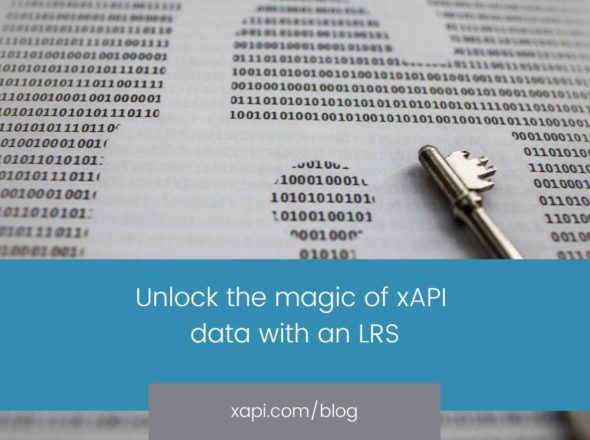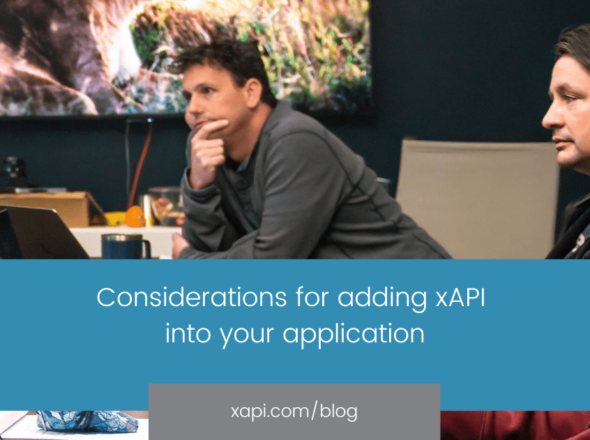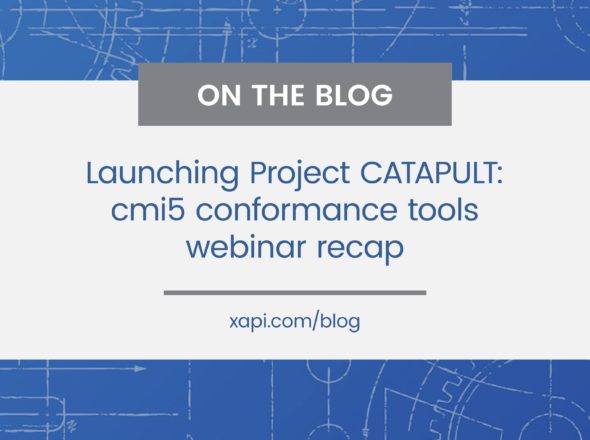On Wednesday, January 21st, 2015, we hosted a webinar about how 8 companies are using the Experience API (xAPI) to do new and innovative things. As usual, the attendees had more questions than we could answer during the live webinar, so we’ve posted the questions and the answers here.
General Questions for Mike Rustici
Question: Is anyone using xAPI as a means of identifying where performance support is needed in order to fill in gaps or augment “weak points” in instruction? This would involve predictive data and identifying any mismatch between learning experiences and actual performance. Hope that question makes sense.
Answer: I don’t think anybody has gotten quite that far yet, but there are a lot of people interested in that use case.
Question: Any open source LRS project out in the field?
Answer: ADL has one designed as an example system. Learning Locker produces one. Those are the only ones that we know of, but there are probably some other efforts underway.
Question: Are you capturing Quickpoll results using xAPI? 😀
Answer: No, but I wish we were! Anybody have a good contact at Citrix we can talk to about having GotoWebinar generate xAPI statements?
Question: Mike, we are on the verge of choosing an LMS. Many vendors are dismissive of xAPI saying that it is not really a standard. How would you respond to that?
Answer: I have many responses.
I might begin by putting on my spec-nerd hat and agreeing with them. xAPI is a specification, not a standard. To us spec-nerds there is an important difference. To laypeople the only difference is whether something has undergone several years worth of bureaucratic process to have it formally blessed. Currently xAPI is a specification that is ready for adoption but has only just begun the long process of formal standardization.
When LMS vendors are dismissive of xAPI it is often because they are afraid of it or because they don’t know what to do with it yet. Fully embracing xAPI is hard. It is paradigm shifting. It is likely disruptive to many legacy business models.
Many vendors are waiting for their customers to tell them exactly why they want xAPI support and what they want to do with it. Their general impression is that customers hear a lot of buzz, but don’t have specific needs or requests.
You can help LMS vendors to adopt by giving vendors specific requests and capabilities you would like to see. xAPI enables so many different things, it can be helpful to narrow down requests and provide priorities. If that doesn’t work, then take your business to the pioneering early adopters like RISC that we heard from on this webinar.
Question: How is the user identified when using a QR Code?
Answer: QR codes are typically scanned on a mobile device. Typically your mobile device knows who you are so that is the most likely source of user identification.
Question: I have one question on TInCan xAPI – Being a technical Specialist I understand the xAPI architecture, but when it comes to explain it laymen term i don’t know how to describe it. In one of the latest Game App (Offline version) where we used our own LMS for tracking using the custom webservices in SCORM table.
Answer: The way I like to describe it is “a new way to capture all of the learning events that are happening in your organization”…but I’ll often tailor my explanation depending on the layman I’m talking to.
Question: I use Moodle LMS to host my flash video for teaching. Limitation I have at the moment that it can not be played on IOS and anderoid devices. How can xAPI help to solve my problems?
Answer: Unfortunately xAPI can’t make Flash work on iOS devices. 🙁 It would be quite the feat if it could!
Question: These are interesting presentations. Are there any rapid development tools (like Captivate or Storyline) that allow the creation native mobile apps that will function in a disconnect environment, and send back learner results when connected?
Answer, from Andrew Downes: There are a number of authoring tool vendors I’m aware of that are working on offline tracking on mobile devices and I hope we can feature some of them in a future webinar. One tool that offers offline-tracked content today is Luminosity Mentor by CM Group who you heard from in the webinar. Mentor is a mobile app that can play content created in the Luminosity Create authoring tool.
CM-group
Question: Is the Luminosity LMS from the same grp that provides the Luminosity games?
Answer, from Alex Mackman: No – I think the question relates to the “Lumosity” (note the different spelling) brain training games. We suffer from that confusion quite a lot. We are in no way related.
Knowledge Guru
Question: what types of data would not track in the SCORM version that are now tracked in xAPI?
Answer, from Steven Boller: The SCORM version tracks overall game completion and score. The Experience API/Experience API version currently shows account creation date, completion of individual sections of the game, overall completion and score. Since Knowledge Guru already provides comprehensive tracking of learning objectives, questions and custom fields in its internal database, our purpose for adding the Experience API was to allow clients who want to use the platform’s full feature set to do so and still have completion data automatically pushed to their central LMS system. We plan to add more Experience API statements as customer demand increases.
Riptide
Question: How do you make sure the users are ‘unique’ across different LRS’s? How does a ‘game’ or ‘a website’ know which UserID to use to send data to the LRS or multiple LRSs?
Answer, from Nick Washburn: The site has an authenticated user – and you create the sites authenticated user into an “account” the “account” consists of name (relates to username in authentication system), and homepage (the address of the authentication system). This is also how we ensure the users are ‘unique.’
Question: We hear a great deal how relatively easy it is to pull user data from mobile devices such as smart phones. However, I am really curious about the device used to capture target/shooting data in this case study. Can you share a bit more about the device (TRACR) and how easy or difficult it was to get the xAPI to send data to the LRS?
Answer, from Nick Washburn: TRACR is not a device or game…it is an automated live fire training range, targets pop in a ‘scenario’. TRACR captures the bullet shots and we listen for those events. We constructed one xAPI statement per event. The complexity depends on how much data a system exposes and the granularity of statements you require. With it TRACR was relatively simple because TRACR exposes all the data we needed. An exercise we used to determine what data we needed was to create a finite state machine where every edge that transitions from one state to the next is an xAPI statement we can collect. Once we determined that we had all of the transitions we could map the process of a soldier shooting, using TRACR, into xAPI statements.
Question: IMI=Interactive Media?
Answer, from Nick Washburn: Interactive Multimedia Instruction.
Question: Nick, over what timeframe was the REAPER project executer (for both integration and reporting functionality)?
Answer, from Nick Washburn: We worked on this R&D project over the course of 11 months. It is still running and collecting data at the range.
Question: Can the game pull info from the LRS in real time (eg in order to influence game play)?
Answer, from Nick Washburn: Again TRACR/REAPER is not a game. But, yes we can. This is how we were able to deliver remedial information with the IMI “just in time”.
RISC
Question: Question about RISC example. What happens to the annotations when the base document (PDF) is updated? How are the locations of the annotations kept in sync? For example if a new page is added to the PDF?
Answer, from Art Werkenthin: That’s a good question. We encouraged the customer to use an e-reader format, where the annotations could be more easily synched when the documents were modified. Due to their extensive PDF library, and a very short time frame (the entire project was completed in 7 weeks), they opted to stay with the PDF format. In this format, minor corrections can be handled, but the addition of pages or even paragraphs of text can throw the synchronization off. Fortunately, for this customer, their documents are relatively static over the course of a training “season”. They felt it was an acceptable risk compared to their previous process, which handed out the documents on a USB drive. As they move towards document revisions based on student annotations I am hopeful they will decide to move to an e-reader format.
Question: Did he say he worked with Making Better to do the visualizations?
Answer, from Art Werkenthin: Yes, we did work with Making Better on the Annotator dashboards.
TES
Question: How do people feel about you tracking when the device is off – in terms of privacy?
Answer, from Nick Stephenson: We only grab and send GPS coordinates when an observation checklist is being undertaken, we don’t collect any other GPS data.
Question: Is anyone using their system to record mentoring programs?
Answer, from Nick Stephenson: It depends on your definition of mentoring!
We have a couple of examples.
TES Coach is used for clients ‘sales mentoring program’, but by definition these may better be described as coaching programs given they really focus on specific behaviours and performance.
TES Coach is used in a medical environment to manage the relationship between trainee doctors and their supervisors. In this instance the app is used to track conversations and discussions around specific treatment of patients or generic topics.
Tessello
Question: I am new to xAPI but .. can you only get “credit” for learning activities or can you also get credit for job-based performance information (without a second person watching/observing)?
Answer, from Jonathan Archibald: We can think of a couple of ways of doing this. The first and probably most simple is Tessello’s ‘Assignment’ resource, which allows learners to upload evidence from outside of Tessello and log it against a particular task. For example, the assignment could be something like “close five sales in the next week and provide supporting evidence”. The learner could then, for example, upload screenshots from their CRM platform using xAPI attachments. This is a low tech, hands-on, but simple and effective way of doing this.
A more automated method would be to link the CRM and Tessello so the former can send xAPI statements to the LRS within Tessello – however this requires the CRM or other external system to support xAPI, or a custom-built integration engine to query the CRM and create the xAPI statements to send to the LRS. We are starting to work with our clients to make this level of cross-platform integration happen, and are excited about both our early results and the long-term possibilities it offers.
Question: With all the different types of social media how are the rates of users actually engaging with these features?
Answer, from Jonathan Archibald: The fact that learners are already engaged with social media tools outside of work makes the inclusion of social features in Tessello more intuitive and clear. What we find makes the real difference is matching that social interaction to a particular learning initiative. Sharing and ‘social’ working more generally should be for a purpose, linked back to particular objectives, competencies and value/incentive for the learner. The ability to track this with the xAPI provides quantifiable evidence of the more natural, informal activities that people already do inside and outside work. Providing these features inside a learning platform gives structure to the tools, and leads to more sharing of relevant content.
We’re also finding that people are sharing things in the context of Tessello like they normally would if they were sitting next to each other in the office: templates, best practice, ideas and interesting links – even the water cooler stuff tends to be anchored to a concrete ongoing project or initiative. Tessello and the xAPI integration gives that ‘the desk next to mine’ feel, across physical and organisational divides.
Torrance Learning
Question: Was multiple kid proximity an issue?
Answer, from Megan Torrance: Yes! It’s not so much a technical issue, though. RFID and the new beacon technologies handle multiple tags just fine. And where SCORM would have a difficult time with multiple simultaneous users, xAPI really doesn’t. The issue that remains, then, is a functional one. Since kids on a field trip often go through the museum in groups of 3-5 with a chaperone, we decided that all the kids in a certain range of the exhibit get “credit” for the interactions. It’s something that, in our next phase of testing, we’re going to be validating a bit more both with student groups and with teachers.
ZebraZapps
Question: Can this be used with Lectora?
Answer, from Christopher Allen: Any published app created in ZebraZapps can be embedded in a Lectora project using Lectora’s External HTML Object. The steps are very simple, and are akin to embedding a ZebraZapps app in a webpage or blog. In addition to Lectora, ZebraZapps apps can also be embedded in Articulate, Captivate and PC PowerPoint Slides.
Authors will often use this feature to refresh older courses or work done by others with richer interactive simulations built using ZebraZapps. For example projects using this technique, contact sales@zebrazapps.com.


